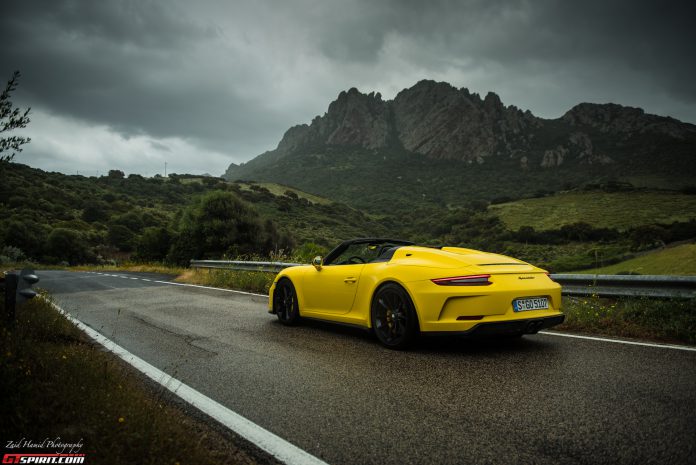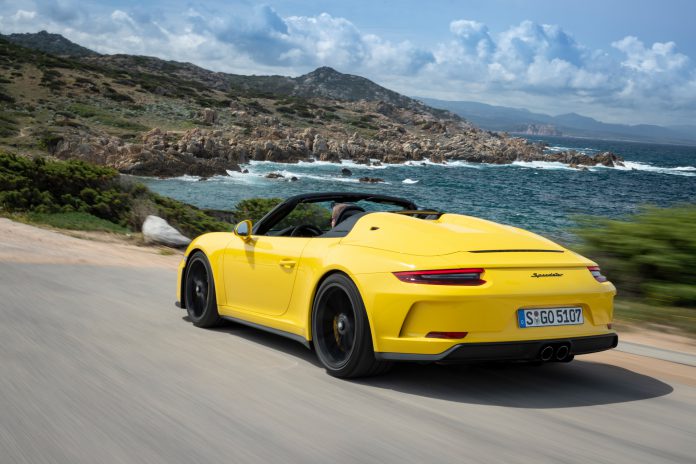It has been a strange, Porsche dominated few weeks – this is by no means a complaint. A few weeks ago, I was in Trump Land for the New York International Auto Show 2019 to see the Porsche 911 Speedster in its final form, finally unveiled for the first time. I say this having seen two design studies over the past few years. Upon my return to London I drove a 911 GT3 RS for a week before driving it to Zuffenhausen (the Porsche factory). Now I find myself in Sardinia, Italy to drive the Speedster. It is as if the 992 had not yet been released given the amount of 991 seat time I have had of late.
You would think Sardinia would be the ideal place to drive such a special car, one designed to be enjoyed in the Mediterranean heat with the sun beating down on hot sticky tarmac. I envisaged such a scene and eagerly anticipated my chance to drive one of just 1,948 Speedsters. Such opportunities are bonafide once in a life time blasts. I am sure then that you will share my sadness when I woke up, coincidently on my birthday, to find heaving grey clouds shrouding the Italian hill tops. The plan was to hit the road at 0900, the very hour the clouds were due to let loose. Skip the birthday breakfast, I was out at 0800. I would have a birthday every year, who knows when I could next be sat behind the wheel of a Speedster.

With the roof manually retracted, I shifted into first and onto the deserted Italian streets. I say that I shifted into first as there is no PDK option. As sublime as the dual clutch transmission is, the absence of a gearbox option is a statement of intent from Porsche – this is a car designed for the thrill of driving and not much else. Previous missions with similar design briefs include the 911R, GT3 Touring and Cayman GT4, cars that will be noted in history as some of the greatest modern Porsches ever built. The pressure is on for the Speedster to join such illustrious ranks.
This 991 Speedster is a departure from the models of past. Not only will it be produced in the thousands, not the tens or hundreds and is, for the first time, a GT department project. By mating a Carrera 4 Cabriolet rear end with the front end of a GT3 and using the GT3 engine, this is a step into the unknown for the Speedster series of swan songs. It also makes it one of the most exciting propositions yet.
Back into the driver’s seat. The 918 buckets are hugging me, I’m in that sublime seating position looking over the analogue dash which I prefer infinitely over the digitised 992 instrument cluster. Grab the stubby carbon fibre trimmed shifter and away I go. It must be said that the clutch pedal is remarkably long, the vast majority of the pedal movement has no impact on the clutch plates – you quickly become accustomed to the effective operating window and no longer flex further than required.
The gearshift throw is short and it is all very sedate crawling through town at less than 3,000rpm. Without a roof in place, it is apparent that this car sounds slightly different to the conventional GT3 or GT3 RS. Low down the sound is slightly flatter, the reason being the introduction of the particulate filter than has been known to rob precious exhaust sound. Boo, hiss. Porsche engineered a masterpiece of a solution to minimise the effect and actually save 10 kilograms in the process. The sound deadening in the exhaust was reduced and the filter used as a substitute. It’s a remarkable feat, but the sound is just a few decibels lesser than before.
Other mechanical changes include the introduction of another impressive engineering addition – individual throttle bodies, proper race car technology. The results of this tech, in conjunction with even higher-pressure direct injection, means that the 4-litre is more responsive and gains 10bhp – the total now a meaty 503bhp.
In reality I struggled to feel this improvement, the car still feels mighty quick to react to throttle inputs courtesy of a strong torque curve. I am under-qualified to critique such precise changes.
The 911 Speedster will do 0-100km/h in 4 seconds, but that is irrelevant. It’s how it makes you feel getting there – magnificent. Acceleration in second gear is ferocious, ever amplified by the build-up of the noise. I mentioned it sounded a bit flat. When deploying full throttle or anywhere above 4,000rpm the engine lets out a bellow that quickly contracts cheek muscles drawing an involuntary smile. Keep pushing to peak power at 8,500 and the noise is a cacophony of natural aspiration that puts engines with double the number of cylinders to shame. The 503bhp is working at 8,500 but you hang on till 9,000 just to relish and be dumbfounded by the wall of noise.
You can comfortably enjoy the upper echelons of the rev range too. The traction, as with all 911s, is staggering on the supreme Cup 2 Michelins. Approach a bend and the front end is, typically, a tad light but instils confidence, the steering proving just how great electronically power assisted steering has become. The rear wheel steer makes the car pivot and on the exit past the apex you can pile on the throttle and pull for another gear with implicit trust.
Things are no worse when downshifting either. The auto blip function matches the revs perfectly, the engine yelping as the revs spike. Slowing down is just as exciting as speeding up, the standard carbon ceramics making their presence known.
I just wanted to drive and drive until I ran out of road. Then came the rain. My time in the dry was all too brief and I hope to, once again, wake up and skip breakfast to be able to revel in the momentous driving experience that the Speedster offers those fortunate enough to own a set of keys. The rain began and I did what I suspect no Speedster owner will ever do. I carried on, not stopping to raise the roof but instead feeling for where the traction was scarce, listening not to the radio – this car had no infotainment system – but to the rain drops pounding the windscreen, the wide tires passing through puddles and feeling the precipitation on my skin. Rain or shine, the Speedster is special. This is Porsche at its best.

